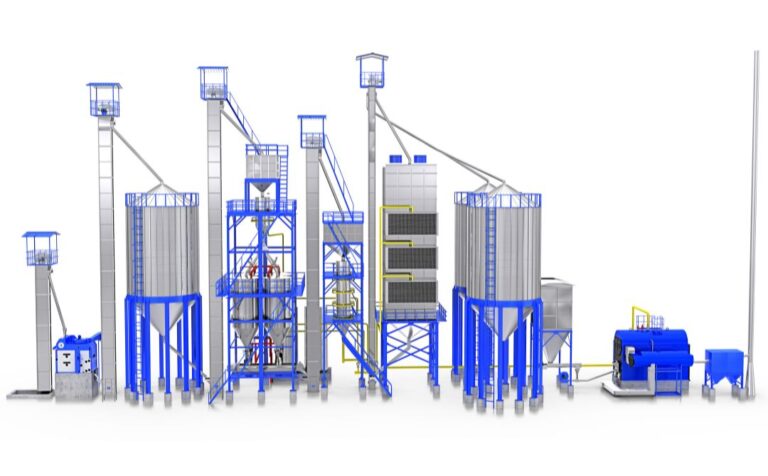Table of Contents
The journey from harvest to market hinges on effective storage. With India producing over 135 million tonnes of rice annually, preserving grain quality is critical for millers, traders, and farmers aiming to maximize profits and meet market demands.
Silo storage for rice offers a modern solution, replacing outdated methods like traditional bag storage with efficient and durable systems. For rice parboiling businesses, grain storage systems like silos ensure quality, reduce losses, and save ₹50,000-₹10 lakh yearly.
This blog explores what is a grain silo, understanding the basics of bulk storage, the top 10 benefits of using silos for rice storage, and practical steps to adopt paddy storage solutions, empowering your post-harvest grain handling for a sustainable future.
Paddy processing is a cornerstone of India’s agricultural economy, yet rice storage problems like spoilage, pest infestation, and moisture damage cause losses of 5-10% annually, costing ₹1-5 lakh per 100 tonnes. Traditional methods, like jute bag storage, expose paddy to humidity, rodents, and mold, reducing quality and market value.
Silo storage for rice addresses these challenges with controlled environment storage, maintaining grain integrity and ensuring compliance with FSSAI standards. By adopting bulk grain storage, millers can boost profits by ₹50,000-₹10 lakh per 500 tonnes while supporting India’s food security goals. Let’s uncover how do grain silos prevent rice spoilage and why silos are essential for paddy processing.
A grain silo is a tall, cylindrical structure, typically made of galvanized steel, designed to store paddy or rice in bulk (10-1,000 tonnes). Unlike silo vs bag storage, silos use controlled environment storage with ventilation, temperature control (15-25°C), and humidity regulation (<65%) to preserve grain quality.
Equipped with loading/unloading systems and sensors, automated grain silos minimize labor and spoilage. A 100-tonne silo stores 100,000 kilograms, protecting against pests and weather, unlike bags that lose 5-10% to spoilage.
The top 10 benefits of using silos for rice storage make them indispensable for paddy processing:
- Spoilage Prevention
How do grain silos prevent rice spoilage? Controlled temperature (15-25°C) and humidity (<65%) reduce mold and bacterial growth, preserving 95-98% of grains.- Impact: Saves ₹50,000-₹2 lakh per 100 tonnes.
- Cost: ₹50,000-₹2 lakh for ventilation systems.
- Pest Protection
Silos are sealed, preventing rodents and insects that damage 5-10% of bagged rice.- Impact: Saves ₹20,000-₹1 lakh per 100 tonnes.
- Cost: ₹10,000-₹50,000 for pest-proofing.
- Space Efficiency
Bulk grain storage in silos (10-1,000 tonnes) uses 50-70% less space than bags (100-150 kg/m² vs. 500-1,000 kg/m² for silos).- Impact: Frees land for other uses.
- Labor Savings
Automated grain silos use conveyors and sensors, reducing labor needs by 50-70% (₹50,000-₹2 lakh yearly).- Impact: Streamlines post-harvest grain handling.
- Cost: ₹1-5 lakh for automation.
- Quality Maintenance
Silos maintain grain moisture (10-12%), ensuring 70-72% head rice yield for export markets.- Impact: Boosts revenue by ₹1-5 lakh per 100 tonnes.
- Long-Term Storage
What is the lifespan of a modern grain silo? 20-30 years, storing rice for 12-24 months vs. 6-12 months for bags.- Impact: Reduces spoilage losses.
- Compliance
Silos meet FSSAI storage standards.- Impact: Ensures legal operations.
- Cost: ₹10,000-₹50,000 for audits.
- Cost-Effective Scaling
Silos allow bulk handling, reducing storage costs by ₹5-10/kg vs. ₹10-20/kg for bags.- Impact: Saves ₹2-10 lakh per 1,000 tonnes.
- Environmental Benefits
Silos reduce pesticide use and waste, supporting eco-friendly storage.- Impact: Cuts landfill use by 5-10 tonnes per 100 tonnes.
- Automation and Monitoring
The role of automation and sensors in modern silo systems includes IoT sensors for real-time temperature and humidity tracking, reducing spoilage by 90%.- Impact: Enhances efficiency.
These benefits highlight why silos outshine silo vs bag storage problem
Challenges and Solutions
Rice storage problems in adopting silos include:
- High Initial Costs: ₹5-50 lakh for silos vs. ₹50,000 for bags.
- Solution: Start with smaller 10-50 tonne silos and scale up.
- Technical Expertise: Automation requires training.
- Solution: Invest ₹10,000-₹50,000 in operator training.
- Space Requirements: Silos need 10-50 sq. meters.
- Solution: Use vertical designs for small mills.
- Maintenance: Yearly upkeep costs ₹50,000-₹2 lakh.
- Solution: Budget for automated systems to reduce long-term costs.
Is Silo Storage Worth the Investment for Small to Medium Mill Owners?
For mills processing 50-500 tonnes monthly, a 10-100 tonne silo saves ₹50,000-₹5 lakh yearly on spoilage, labor, and pesticides. ROI is achieved in 2-3 years, with long-term gains from higher-quality rice.
Steps to Implement Silo Storage for Paddy Processing
Ready for modern rice storage solutions? Follow these steps:
- Assess Storage Needs: Calculate paddy volume (e.g., 100 tonnes/month needs 50-100 tonne silo).
- Choose Capacity: Select 10-1,000 tonne silos for grain storage systems.
- Budget: Plan ₹2-50 lakh setup, ₹50,000-₹2 lakh yearly maintenance.
- Select Vendor: Partner with BIS-certified suppliers like SKF Elixer.
- Install Automation: Add sensors for controlled environment storage.
- Train Staff: Spend ₹10,000-₹50,000 on training for post-harvest grain handling.
Conclusion
Silo storage for rice is a game-changer for India’s paddy processing industry, tackling rice storage problems and delivering top 10 benefits of using silos for rice storage. From spoilage prevention to automation, silos save ₹50,000-₹10 lakh yearly while ensuring quality and compliance. The role of automation and sensors in modern silo systems enhances efficiency, making silos superior to traditional bag storage issues.
FAQs
Q1: What is a grain silo?
A grain silo is a galvanized steel structure (10-1,000 tonnes) for bulk grain storage, using controlled environment storage to preserve rice, reducing spoilage by 95-98%.
Q2: How do grain silos prevent rice spoilage?
Maintain 15-25°C and <65% humidity, with ventilation and sensors, cutting mold and pest losses by 90%.
Q3: What are the top 10 benefits of using silos for rice storage?
Spoilage prevention, pest protection, space efficiency, labor savings, quality maintenance, long-term storage, compliance, cost savings, environmental benefits, and automation.
Q4: What is the role of automation and sensors in modern silo systems?
IoT sensors monitor temperature/humidity, reducing spoilage by 90% and labor costs by ₹50,000 yearly.
Q5: Is silo storage worth the investment for small to medium mill owners?
Yes, 10-100 tonne silos save ₹50,000-₹5 lakh yearly, with ROI in 2-3 years.
Q6: What is the lifespan of a modern grain silo?
20-30 years, storing rice for 12-24 months with minimal maintenance.
Good reads are meant to be shared









